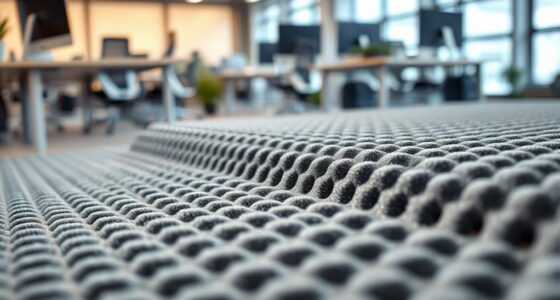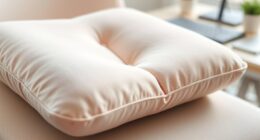Anti-fatigue mats are scientifically designed to reduce muscle fatigue and discomfort caused by prolonged standing. They absorb shocks, cushion your feet, and distribute pressure evenly, promoting better circulation and reducing strain on your muscles and joints. Materials like high-density foam or rubber make a big difference in durability and support. Using one can boost comfort and safety in your workspace. Keep exploring to discover how choosing the right mat can improve your long-term health.
Key Takeaways
- Anti-fatigue mats utilize shock-absorbing materials like foam or rubber to reduce impact and muscle strain during prolonged standing.
- They promote better blood circulation by evenly distributing pressure and supporting natural ergonomic postures.
- Scientific studies show these mats decrease muscle fatigue markers and discomfort over extended standing periods.
- Proper design and material durability ensure sustained cushioning, enhancing long-term comfort and safety.
- Using anti-fatigue mats improves workplace safety, reduces fatigue-related injuries, and boosts productivity.
How Standing Affects Your Body: The Basics
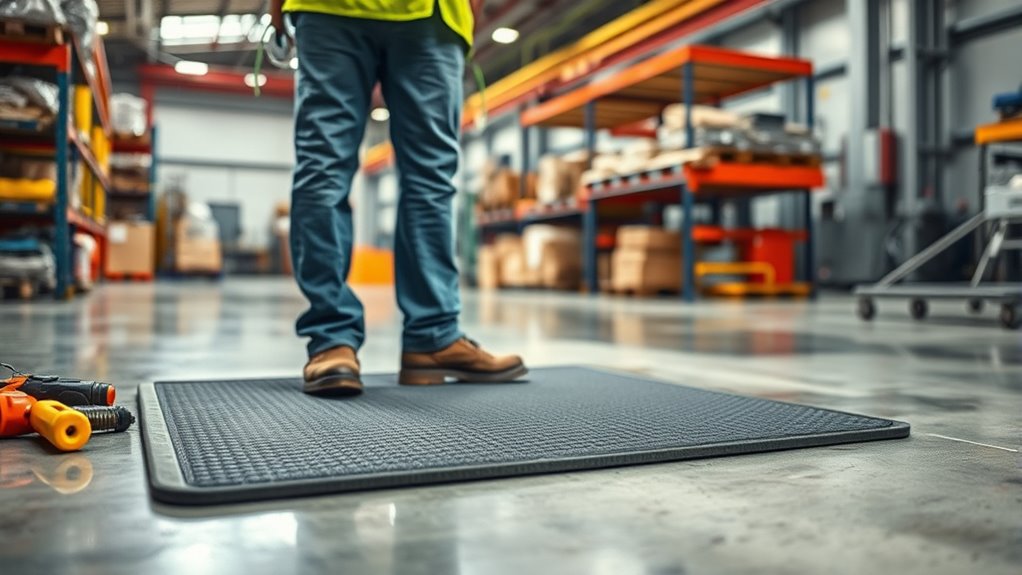
Standing for long periods puts strain on your muscles and joints, which can lead to discomfort and fatigue. When you stand without proper support, your body tends to adopt an ergonomic posture that can cause muscle fatigue over time. Poor posture strains your lower back, legs, and feet, increasing tension and reducing circulation. Without relief, these stressors accumulate, making you feel more tired and uncomfortable. Maintaining good ergonomic posture while standing helps distribute weight evenly and minimizes strain on specific muscles. Additionally, tuning techniques can optimize your body’s efficiency and reduce fatigue during extended periods of standing. However, prolonged standing still takes a toll, highlighting the importance of supportive solutions. Anti-fatigue mats can help by reducing muscle fatigue, allowing you to stand more comfortably for longer periods. Proper support and posture are key to avoiding unnecessary stress on your body.
The Role of Shock Absorption and Cushioning
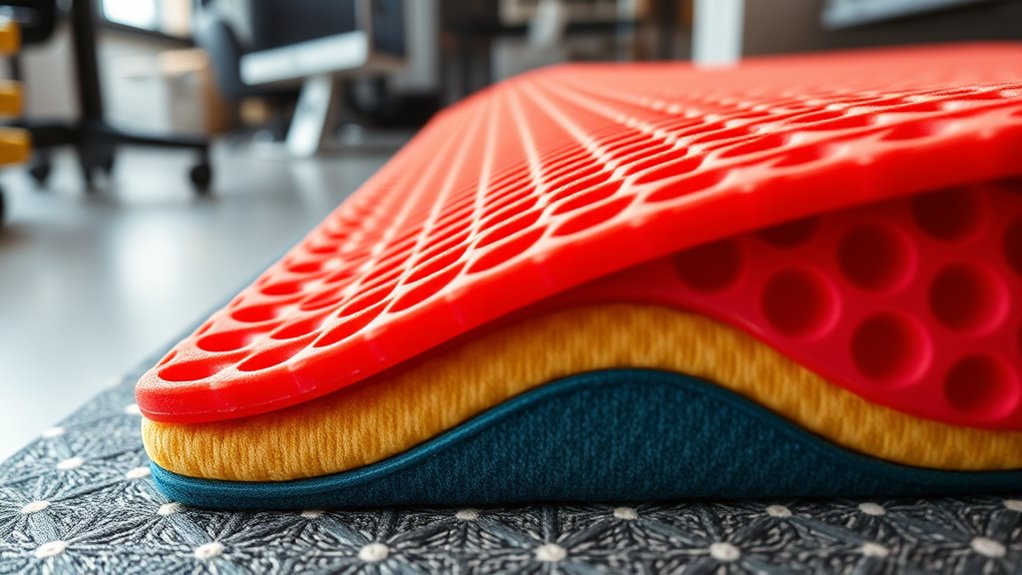
Shock absorption and cushioning play a vital role in reducing fatigue when you stand for long periods. The right materials can absorb impact and provide better support, making your workday more comfortable. By choosing mats with effective shock absorption, you’ll notice less strain and increased overall comfort.
Impact on Fatigue Levels
Have you ever noticed how tiring it can be to spend long hours on a hard surface? That fatigue isn’t just in your legs — it affects your entire body. Anti-fatigue mats help reduce muscle fatigue by improving ergonomic posture, which minimizes strain. Their cushioning absorbs shock, easing the impact on your joints and muscles, so you stay comfortable longer. The following table shows how different factors influence fatigue levels:
| Factor | Effect |
|---|---|
| Shock absorption | Decreases muscle fatigue |
| Ergonomic posture | Reduces strain on muscles |
| Cushioning | Supports prolonged standing comfort |
Additionally, integrating automation technologies in workplace environments can further enhance productivity and reduce physical strain.
Material Shock Absorption Properties
Since your joints and muscles bear the brunt of prolonged standing, choosing mats with excellent shock absorption is essential. The material’s durability guarantees it maintains its shock-absorbing qualities over time, providing consistent support. High shock absorption efficiency means the mat can absorb impacts and reduce the force transmitted to your body, helping prevent fatigue and discomfort. Look for materials like high-density foam or rubber, which are known for their resilient shock-absorbing properties. These materials compress under pressure, cushioning your feet and joints while resisting wear and tear. A well-designed anti-fatigue mat balances material durability with shock absorption efficiency, giving you reliable protection during long hours on your feet. The inclusion of HEPA filters in air purifiers can further improve indoor air quality, reducing airborne irritants that may contribute to fatigue. This combination helps minimize strain and supports your overall comfort.
Enhanced Comfort and Support
By selecting mats with excellent shock absorption properties, you can substantially enhance your comfort and support during long hours on your feet. An ergonomic design ensures that the mat contours to your movements, reducing strain and fatigue. The right material durability guarantees consistent cushioning without breaking down over time, maintaining your comfort day after day. Well-designed anti-fatigue mats absorb impacts and distribute pressure evenly, preventing sore spots and discomfort. This high-quality construction not only extends the lifespan of the mat but also ensures consistent performance under heavy use. This combination of supportive cushioning and sturdy construction helps you stay focused and less prone to injury. When choosing a mat, prioritize features that promote ergonomic benefits and long-lasting durability, so you get superior support and comfort throughout your work shift.
Understanding Pressure Distribution and Circulation
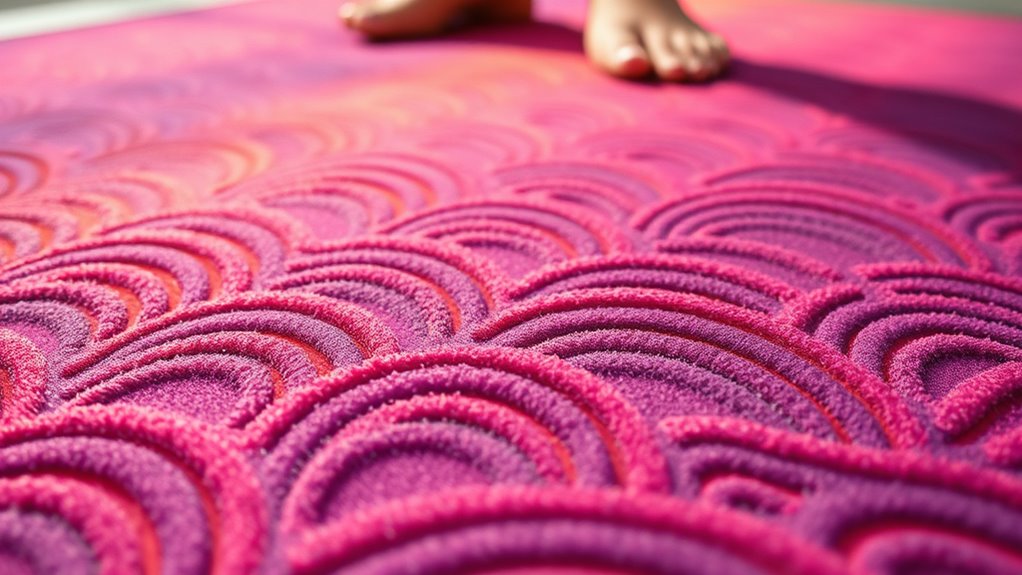
Understanding pressure distribution and circulation is essential for maximizing the benefits of anti-fatigue mats. When you stand on a hard surface, pressure points develop in your feet, leading to discomfort and fatigue. An anti-fatigue mat helps distribute your weight more evenly, reducing concentrated pressure on specific areas. This even distribution encourages better blood flow, preventing stagnation and promoting circulation throughout your legs and feet. Improved circulation means oxygen and nutrients reach your muscles more efficiently, decreasing fatigue and discomfort over time. Additionally, expert voice actors often utilize immersive soundscapes to create engaging content that enhances understanding. By balancing pressure and enhancing circulation, the mat supports your body’s natural biomechanics, helping you stay energized and comfortable during long periods of standing. Proper pressure distribution is key to access the full anti-fatigue benefits these mats can offer.
Materials and Design That Enhance Comfort
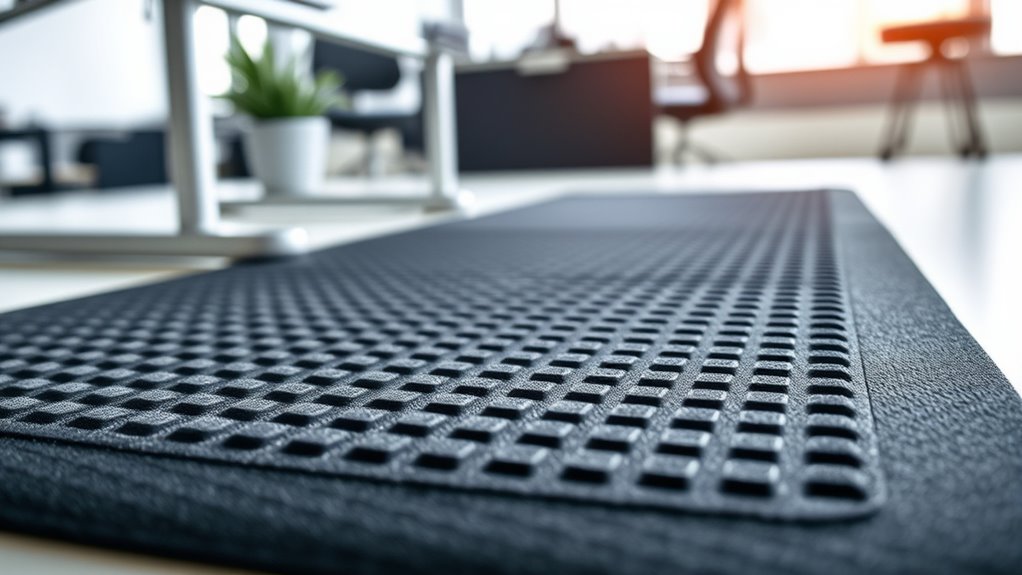
The materials and design of anti-fatigue mats play a crucial role in maximizing comfort during prolonged standing. An ergonomic design ensures that the mat supports your body’s natural posture, reducing strain on your legs, back, and feet. High-quality materials contribute to both comfort and durability, so your mat remains supportive over time. Look for mats made from resilient foam or rubber that can withstand daily use without losing shape or cushioning. The thickness and surface texture also matter; a well-designed mat absorbs shock while providing enough grip to prevent slipping. When choosing an anti-fatigue mat, prioritize those with sturdy construction and ergonomic features that promote comfort and safety, helping you stay on your feet longer with less fatigue. Incorporating Glycolic Acid Benefits for Skin into your skincare routine can also improve skin texture and overall appearance, complementing your focus on well-being.
Scientific Studies Supporting Anti-Fatigue Benefits
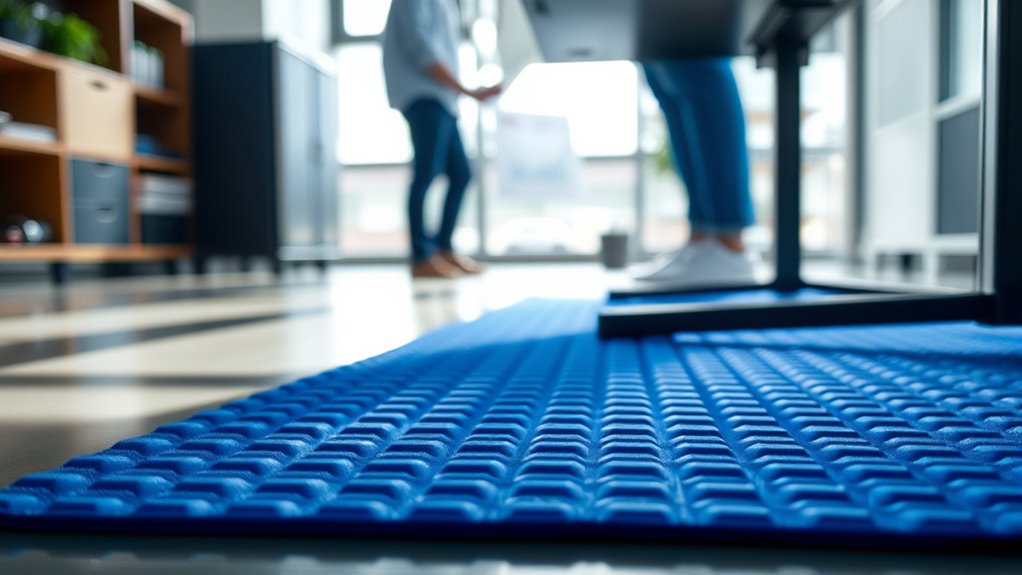
Numerous scientific studies have demonstrated that anti-fatigue mats can considerably reduce muscle fatigue and discomfort during prolonged standing. Research shows that ergonomic design plays an essential role in distributing your weight evenly, decreasing pressure on your legs and lower back. The studies also highlight that the durability of the materials used ensures consistent support over time, maintaining their effectiveness. When you stand on a well-designed anti-fatigue mat, it helps improve circulation and relaxes muscles, reducing strain. These benefits are supported by experiments comparing standing on hard floors versus mats, with the latter showing significant decreases in fatigue markers. Additionally, material durability is crucial in ensuring the mat maintains its supportive qualities through extensive use. Overall, scientific evidence confirms that investing in high-quality, durable, ergonomically designed mats can enhance comfort and health during long periods of standing.
Practical Tips for Choosing the Right Mat
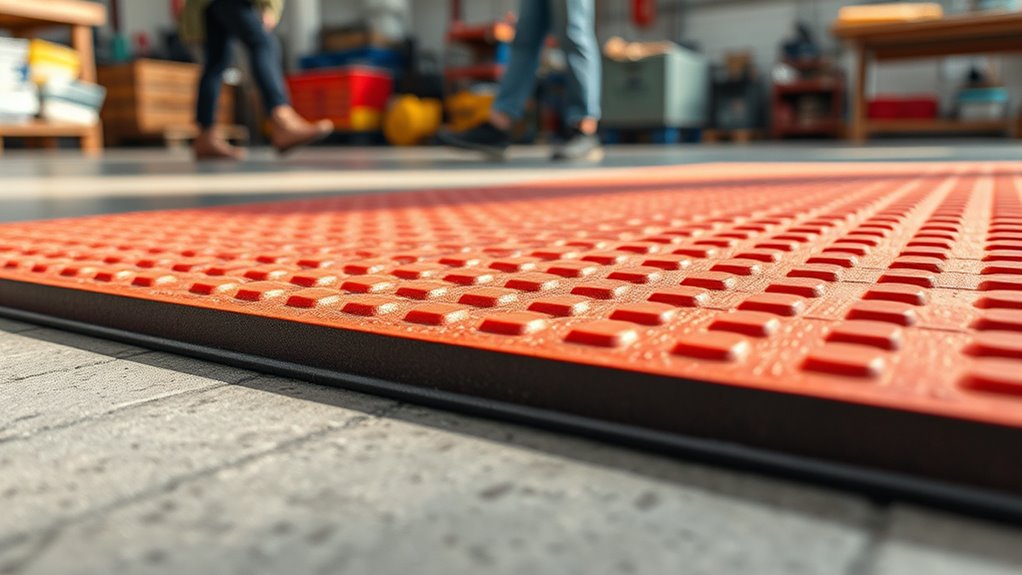
Choosing the right anti-fatigue mat involves considering several key factors to guarantee it meets your specific needs. First, assess your work environment to ensure the mat promotes ergonomic posture, reducing strain on your legs and back. Look for a mat with enough cushioning to provide comfort during prolonged standing. It’s also essential to check flooring compatibility; some mats work better on concrete, while others suit hardwood or tiles. Consider the mat’s thickness and material to match your activity level and moisture exposure. Additionally, ensure the size fits your workspace and allows free movement. Choosing a durable, non-slip surface enhances safety. Incorporating features like glycolic acid exfoliation can also improve skin health in areas prone to friction and sweat. By paying attention to these factors, you’ll select a mat that supports comfort, safety, and productivity throughout your workday.
Frequently Asked Questions
How Long Should I Stand on an Anti-Fatigue Mat Daily?
You should aim to stand on an anti-fatigue mat for about 2 to 4 hours daily, balancing ergonomic benefits with your standing duration. Longer periods without breaks can lead to fatigue, but using an anti-fatigue mat helps reduce discomfort and improve circulation. Be sure to take regular breaks, stretch, and change your position to maximize ergonomic benefits and prevent strain during your standing sessions.
Are Anti-Fatigue Mats Suitable for Outdoor Use?
Anti-fatigue mats can be suitable for outdoor use if they have weather durability and slip resistance. Look for mats made from materials like rubber or heavy-duty vinyl that withstand moisture, UV rays, and temperature changes. make certain they have a textured surface for slip resistance, especially in wet conditions. Properly chosen outdoor mats help reduce fatigue and improve safety, making them a smart addition to outdoor workspaces or recreational areas.
Can Anti-Fatigue Mats Help Reduce Back Pain?
Did you know that back pain affects over 80% of adults at some point? Anti-fatigue mats can help reduce back pain by providing ergonomic benefits that promote proper posture and comfort. They also encourage circulatory improvement, which reduces muscle fatigue and strain. By standing on an anti-fatigue mat, you support your body’s natural alignment, easing back discomfort and allowing you to work longer without pain.
How Often Should I Replace My Anti-Fatigue Mat?
You should replace your anti-fatigue mat when it shows signs of wear, such as tears, uneven surfaces, or loss of cushioning. The replacement frequency depends on material durability; high-quality mats last longer, often several years, while lower-grade ones may need replacing sooner. Regularly inspect your mat and prioritize safety and comfort. If it no longer provides proper support, it’s time for a new one to prevent discomfort or injury.
Do Anti-Fatigue Mats Emit Any Harmful Chemicals?
Ever wonder if anti-fatigue mats emit harmful chemicals? Generally, these mats are designed with chemical safety in mind, using non-toxic, durable materials. High-quality mats undergo testing to ensure they don’t release volatile organic compounds (VOCs) or other toxins. Material durability is vital here, as it prevents the breakdown of unsafe substances over time. So, investing in a reputable product helps you stay safe while enjoying the comfort and benefits these mats offer.
Conclusion
So, next time you’re on your feet all day, imagine a magical carpet turning your aching legs into happy, bouncing springs. Instead of feeling like you’ve run a marathon on concrete, you get to glide through your workday on a cushioned cloud. Anti-fatigue mats aren’t just fancy floor decorations—they’re your secret weapon against tired limbs and poor circulation. Trust me, your feet will thank you, and your boss might even wonder how you stay so energized!


